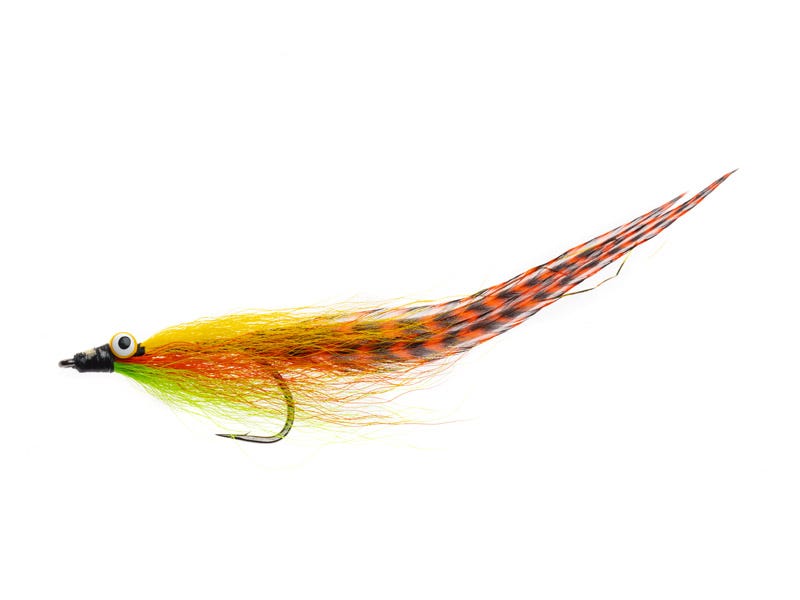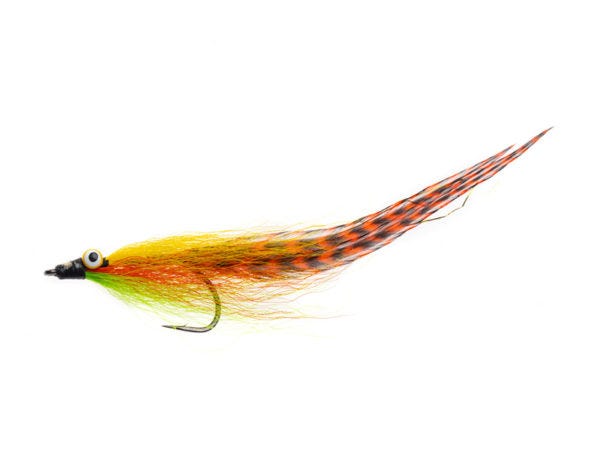Fly Recipe: Half & Half


Half & Half
The Half & Half is a blast to tie. It has a simple format that is easily tweaked by changing the colors and sometimes the materials that you use. Part Lefty’s Deceiver, and part Clouser Minnow, these are great flies to have for the avid smallmouth fisherman’s fly box. Fished on a sinking tip or intermediate line around structure, you can fool bass and trout alike. My favorite color combos are firetiger, yellow/brown and chartreuse/white.
Material List:
Hook: Gamakatsu B10S 2/0
Thread: Veevus Power Thread 240, Black
Tail: 2 x Orange/Grizzly Saddle Hackles
Flash: Gold Flashabou
Eyes: MFC Painted Lead Eyes, Yellow
Belly: Hareline Large Northern Yellow Bucktail
Underwing: Hareline Large Northern Orange Bucktail
Back/Overwing: Hareline Large Northern Chartreuse Bucktail
Video Transcription
Intro to the Half & Half
I'm Taylor Hess with North 40 Fly Shop in Ponderay, Idaho, and today we're going to be tying the Half & Half. For those of you that are looking for a versatile pattern, look no farther. It's a great cross between Lefty's Deceiver and a clouser minnow, so therefore you can change colors and alter the shape, size, profile to target many different species. So tune in. We're going to have another fun tie today.
Step-by-Step Tying Instructions
All right, thanks for joining us today, guys. Today, we're going to be tying a Half & Half. So first step, you want to dress your hook to just about halfway point between the barb and the point. And then I build up a little bit of a knob, and then I come back out to the point. First step we want to do, we want to select a couple hackles, and you can be pretty selective with your hackles. Really, I just want something that's going to make a nice long tail, something that's going to move a lot. So I'm going to tie those in, one on each side. All right, so we want both of those to splay out, just like so.
All right, so now what we want to do, we want to dress the hook up towards the eye, probably about three-quarters of the way up the fly. And I'm going to use a yellow eye. And as I wrap these dumbbell eyes, I like wrapping from below. I also wrap in front and behind, and that keeps those from rolling around on us too much.
So next step here, I'm going to take some gold flashabou. I'm going to take a pretty nice hunk. I want this to be a nice flashy pattern. So I'm going to take nice little clump, and I want to seat that right behind those eyes, and tie right in over that. And that's going to help cover up the middle of that body. And I want it to come out in between both of those hackles.
So next step is this is going to be the bottom of our fly. I want to choose some yellow bucktail. I like to find some of the longer fibers, so I'm near the tip of the tail. They're going to be some of your better fibers. Want to avoid anything penciling out. Take those out. I'm going to seat this right behind those dumbbell eyes, right on top, and make a few nice hard wraps. I want that to blend all together. Another important thing to do is pass back in front of those eyes, pull that bucktail that you just tied in back up over the top. I want to tie that in nice and tight. Pull it back up, tie in front again. That kind of helps pinch it off. Trim that.
All right, so the bottom of the flight is done. Now we're going to turn it over. And now we're going to do the top of our fly. So first, I'm going to put in a layer of orange bucktail. Find some good fibers. And get all your straggling pieces out. It's really important. If you have too many of those penciling out, your fly might only last a few casts. I'm going to lay that right in on top. I want it to be at least as long as that belly. Sometimes you can make it even a little bit longer. You want to avoid having it splay too much, and also we want to avoid it rolling over the fly. Tie that down. I'm going to tie the whole way up to the eye. That way I have some thread there to tie the rest into.
Alright, last step. We're going to take a nice big section of chartreuse bucktail. Let me get all those fibers out so it doesn't pencil. Now lay that right on top. Keep it from rolling too much. And you want to start building up your head, wrapping the whole way back to the eyes. Going to tie it in front again. And here, I want to cut these as closely as possible. So now you can cover up all of those. When using bucktail I put a lot of pressure. That's why I like using a heavier thread, such as this Veevus 240 Power Thread is definitely some nice stuff. Alright, now we're ready to whip finish. I come back to the head of the fly.
All right, so there you have it. You can hit it up with some UV. Loon makes some pretty decent stuff. It's really important. I even get the bucktail that comes up over the dumbbell eyes as well. All right. And we'll cure that up. Hit it from all angles.
So there you have it folks. That's the half and half, one of the many versions that you can do. You can change up your colors, and depending on your target species, you can make it look like anything. I was thinking about barring the back on this, make it look more like a perch or a fire tiger kind of color. This specific pattern probably be best for small-mouth and even large-mouth pike, and depending on what areas you're in, you could probably find some other things to catch on it. So thanks for joining us today, guys. If you have any questions, feel free to get a hold of us here at any one of our North 40 Fly Shops. And we'll see you next time.
If you have any further questions on fly tying, please come visit us at any of our retail locations or North40.com.
Want to fool a fish on a fly you've created? Learn more fly tying recipes here.
